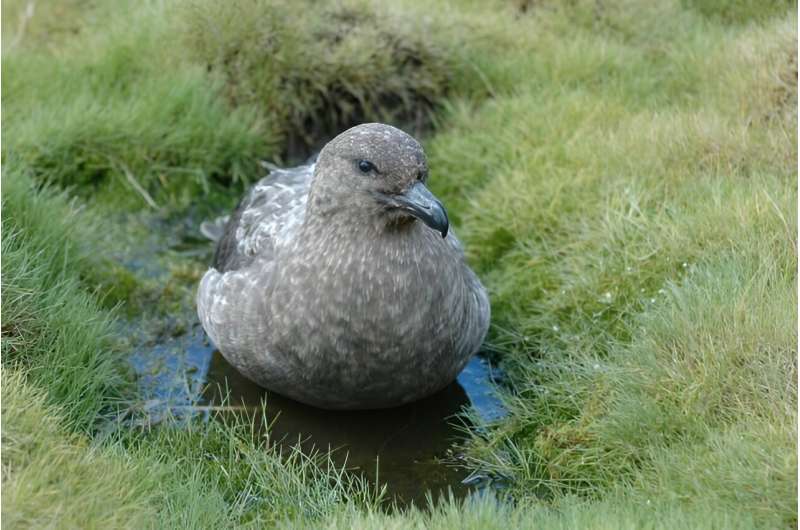This article has been reviewed according to Science X's editorial process and policies. Editors have highlighted the following attributes while ensuring the content's credibility:
fact-checked
trusted source
proofread
First confirmed cases of avian influenza in the Antarctic region

Highly pathogenic avian influenza (HPAI) has been confirmed in brown skua populations on Bird Island, South Georgia—the first known cases in the Antarctic region.
Following reports of several potentially symptomatic birds and unexplained mortality, British Antarctic Survey (BAS) staff on Bird Island took samples for testing. The swabs were returned to the UK and tested by the Animal and Plant Health Agency laboratories in Weybridge, where they returned positive results.
Natural pathways are the primary means of spread of HPAI and it is likely that the spread of the disease was caused by the return of birds from their migration to South America, where there are a high number of HPAI cases. BAS and Government of South Georgia & the South Sandwich Islands (GSGSSI) remain vigilant for further cases and science and visitor programs are currently continuing under enhanced biosecurity measures.
BAS is working in close partnership with the GSGSSI, guided by their tiered response plan to monitor and manage the outbreak. The most recent version of these protocols can be found in the GSGSSI Biosecurity Handbook.
BAS operates two research stations on South Georgia, including one at Bird Island where the confirmed cases were identified. As result of the confirmed cases of HPAI, the majority of field work involving animal handling has been suspended. Biosecurity measures continue, including the enhanced cleaning of clothing and field equipment, and observation of areas of high wildlife density.
Key elements of the wider science program at Bird Island continue under caution, including long-term monitoring of marine predators such as wandering, black-browed and gray-headed albatrosses, northern and southern giant petrels, macaroni penguins, and gentoo penguins. These observations make Bird Island one of the most closely monitored seabird colonies in the world, equipping scientists and conservationists with indicators of change for species.
It is not possible to forecast the impacts of HPAI across South Georgia, given that the patterns of transmission and mortality in Europe and the Americas space has been highly variable. GSGSSI and BAS will continue to work together to monitor the impact of the wildlife at Bird Island, and the potential spread to other areas.
Background on avian influenza
Avian influenza is a viral disease that primarily affects birds. Low pathogenic avian influenza viruses are common in wild birds and often cause no signs of disease. However, some strains of the virus, including H5 and H7, are highly pathogenic in domestic poultry and can cause high mortality if they escape into wild bird populations. These are known as highly pathogenic avian influenza (HPAI).
The current outbreak of H5N1 HPAI began in 2022 and has resulted in the death of high numbers of seabirds in the Northern Hemisphere, the south of Africa and around the Atlantic and Pacific Oceans and throughout South America. While predominantly still a virus that affects birds, during the current outbreak some mammals have been infected. Often this is due to predators and scavengers consuming infected birds or carcasses, but cases have also been noted in some marine mammals where this mode of transmission would not apply.
Although primarily a virus that is spread among birds, the World Health Organization (WHO) has noted that while the number of cases in humans is extremely rare, the increasing number of detections of the current H5N1 strain among mammals raises concerns that the virus might adapt to infect humans more easily.
The primary means of spread of HPAI is though natural pathways and the confirmed presence of the disease on the South American continent made it highly probably that the disease would arrive in South Georgia in the 2023–24 season. In readiness, the Government of South Georgia & the South Sandwich Islands (GSGSSI) updated its guidance on HPAI risk and response in the Territory. These included enhanced biosecurity procedures and mitigation measures to be put in place for different groups/activities depending on the HPAI risk at each visitor landing or science site.
While the source of the disease on Bird Island is not certain, it is likely that it was introduced via skuas returning from their migration in Argentina where there are known to be a high number of cases.
The presence of HPAI could have serious implications for the Territories' abundant seabird colonies and GSGSSI and British Antarctic Survey are working in partnerships to monitor the ongoing impacts.
Provided by British Antarctic Survey

















